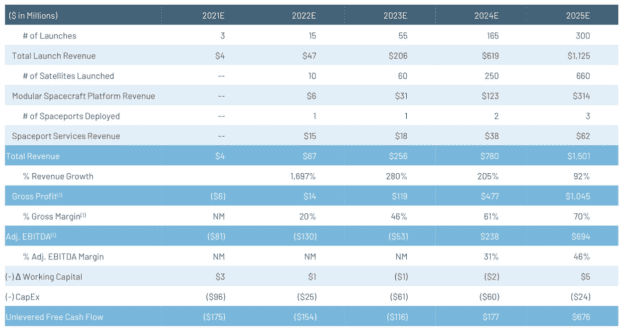What I call the Space Revolution will, over the next five to 10 years, change the world we live in. It will become a multi-trillion-dollar marketplace.
I began writing this Space Revolution report about Astra (which is trading under Holicity
HOL,
I have long followed Rocket Lab and have wanted to invest in it for a long time, and so I immediately shifted focus to it. As I have continued to research everything Space Revolution-related and Astra/Holicity specifically, I am ready to pull the trigger on this name, which broadcasted its intention to leave the private markets a few weeks ago.
In my recent Trade Alert about Rocket Lab, I referred to a handful of space companies coming public via SPACs. Today, I’m bringing you another one of those names that I think has positioned itself to be one of the big winners.
Astra, like Rocket Lab, is being brought public by a SPAC, or a special purpose acquisition company. Astra is similar, and a competitor, to Rocket Lab in that it is building a vertically integrated rocket platform to help customers optimize their ability to get small satellites into orbit. Astra is preparing to go public in the second quarter.
How Astra is different
Although there are many similarities between the two companies, one major difference is in the portable system that Astra uses to launch rockets into space. Astra can pack its launch system in four shipping containers and deliver it along with five people anywhere on the globe and launch a rocket in as little as five days. This mass-produced launch system can be shipped via train, truck, ship or even loaded onto a C-130 transport plane and delivered anywhere in the world.
Chris Kemp, Astra’s CEO, says: “At the foundation of our platform is the software that helps us optimize the cost structure of our business, from our supply chain to the materials and the labor that go into operating our launches and our company, to the systems that allow us to automate the manufacturing and the launch of our rockets. Astra fundamentally is a software company that is understanding and collecting data about every aspect of our business all the time, and that allows our engineers to focus on improving the efficiency, productivity, and cost structure of our space operations.”
Astra builds rockets that are scalable to the point that the company plans on being able to build quickly enough to have daily launches by 2025. Astra’s rocket factory is located on the old Alameda Naval Air Station outside of San Francisco. This former naval jet engine test facility provides some built-in efficiencies for Astra. The company is literally able to have raw materials brought in one door of the factory and then wheel a manufactured rocket out another door and test it on-site.
Unlike other companies, the development, manufacturing and testing occurs on one campus. You can check out a video of the factory here. These efficiencies are evident by Astra’s ability to quickly change its rocket based on changes in the markets in which they serve. After their first test launch in 2018, Astra learned that the market was dictating a larger rocket. Based on customer demand, the company successfully doubled the size of the rocket it launched in 2020.
Another area in which Astra’s efficiencies show is in its work in taking advantage of available space in the rockets. Astra is working on a satellite bus shaped like a disc so that it would be able to efficiently stack the disc satellites on top of one another, efficiently filling up the capacity of the rocket.
This is similar to how SpaceX has stacked its Starlink satellites into a Falcon 9 rocket. Astra’s satellite discs are basically routers for space, building a server-like platform for customers to attach devices such as radios, cameras, etc., directly to Astra’s satellites before they are launched. This concept will allow Astra’s customers to take concepts and payloads, and rapidly deploy them to a constellation in a matter of months, not the years that it would take to design their own satellites.
Ties to NASA
As my team and I have been spending a lot of time researching SPACs recently, a factor in the success or failure of a SPAC is the experience of the team behind the SPAC (both the founders of the company and the sponsor of the SPAC). This is one area where Astra and Holicity really shine. Kemp, the CEO, chairman and co-founder of Astra, has a background in both space and building companies.
Kemp was formerly chief technology officer of a little space organization called NASA, where among other things, he helped form a partnership between NASA and Alphabet
GOOG,
Adam London, a co-founder of Astra, has an equally impressive resume. He was founder of Ventions, which later became Astra, where he worked in a partnership with NASA and DARPA in designing small rockets. London has a doctorate in aerospace engineering from MIT.
Other members of the executive team have been plucked from companies such as SpaceX, Blue Origin, Virgin Galactic
SPCE,
The sponsor of the SPAC, Pendrell, was founded by Craig McCaw. McCaw is a billionaire investor whom I’ve met over the years and who has partnered once again with Bill Gates on this venture. He clearly has had a lot of success in space, telecom and wireless broadband over the past three decades.
Fast timeline to space
Now back to the company itself. Astra got to space faster than any private company in history. It took only four years. As a comparison to other space companies, it took SpaceX seven years, Rocket Lab 12 years and Virgin Orbit 13 years.
After being founded in 2016, Astra had its first “successful” launch in December 2020. I put “successful” in quotes because although it passed the Karman line (100-kilometer altitude, commonly used as the demarcation of space), the rocket ran out of fuel about 12-15 seconds early and didn’t reach orbit.
Astra was “beyond ecstatic” about the launch, and the company believes it can easily correct the problem with a small tweak to the rocket’s fuel mixture of kerosene and liquid oxygen. Here’s the video of the launch.
First commercial launch
Astra is planning its first commercial launch this summer. The company has its first 50 launches under contract, which represent more than $150 million of revenue. In December 2020, Astra was awarded a NASA contract, called Mission One, to launch 30 kilograms of cubesats (miniature satellites) to orbit.
Presenting the award, NASA said: “Astra provided the best value to the agency, the strongest technological solution, and the most mature launch vehicle of their peers.”
In addition to Mission One, Astra was also awarded a February 2021 contract from NASA to launch six additional cubesats into three different orbits in 2022. In this awarded contract, Astra beat out four other competitors, whose names we are familiar with. They include Rocket Lab, Momentus, Virgin Orbit and even SpaceX.
In the source selection statement, NASA said the contract came down to two finalists, Astra and Rocket Lab, with Astra winning based on a much lower price. I am sure that Astra founder Chris Kemp’s time at NASA didn’t hurt either.
Astra has a pipeline of $1.2 billion in contracts being negotiated in areas such as broadband satellites, earth observation satellites and satellites to send data to all the autonomous vehicles in that coming revolution.
Starting with the next launch planned for this summer, the launch cadence increases rapidly. The company expects to scale to monthly launches in the fourth quarter of this year (recently moved up from early next year), to weekly in 2023, biweekly in 2024 and up to daily in 2025.
If that pans out, that’s a lot of revenue. In scaling up to the daily launch capability in 2025, Astra sees economies of scale bringing down costs to build the rockets. The company is targeting a cost of $500,000 to build a rocket capable of launching 500 kilograms in 2025. That cost of $1,000/kilogram of costs compares favorably to that of the larger reusable rockets in the market.
Escalating demand
As demand for small satellite launch rises, Astra has positioned itself in a great place to be one of the few companies able to meet that demand. It sees over 38,000 satellites being built and launched over the next decade, of which about 90% will be the small satellites that Astra is focused launching with its current rocket.
The majority of the demand will come from:
- Global broadband connectivity
- Internet of things (IoT)
- Machine-to-machine
- Earth observation
- National security
- Next-generation weather observation and forecasting, GPS, etc.
These capabilities are being deployed with a large number of small satellites. Due to the upgrade cycle of three to five years on small satellites, Astra and other launch companies will likely have escalating demand for launch services as older satellites get replaced.
The financials
Let’s take a look at the financials. As with a lot of companies going public via a SPAC, Astra currently doesn’t produce much revenue (a forecast of $4 million this year). However, as you can see from the chart below, the company is forecasting revenue to begin increasing exponentially up to $1.5 billion in 2025.

During the investor presentation earlier this month, Astra CFO Kelyn Brannon sees the company becoming both profitable and free cash flow positive sometime in 2024.
As part of the SPAC process, Astra will end up with almost $500 million in cash with no debt at a current valuation of about $3 billion based on the current stock quote of about $12-$13, which they see as fully funding growth until free cash flow begins to fund any additional investments into the business that are needed.
I would be surprised if the company doesn’t come back to the markets for more cash in the next year or two if or when the stock takes off. Also during this time, the company sees growth margins increasing to around 70% when it’s fully up to scale — that would be impressive profitability.
Astra is skating its business to where the Space Revolution is going, not where it has been. It is likely to be one of the big winners in space if it can deliver on its vision.
Cody Willard is a columnist for MarketWatch and editor of the Revolution Investing newsletter. Willard or his investment firm may own, or plan to own, securities mentioned in this column.







